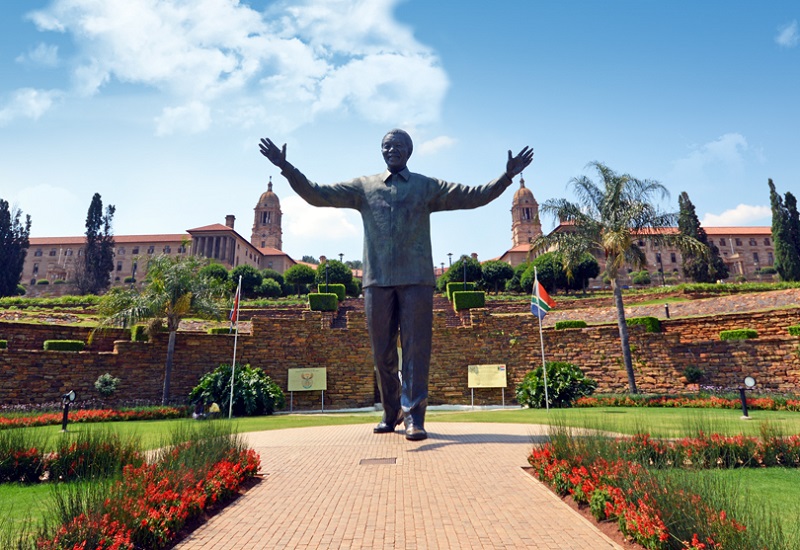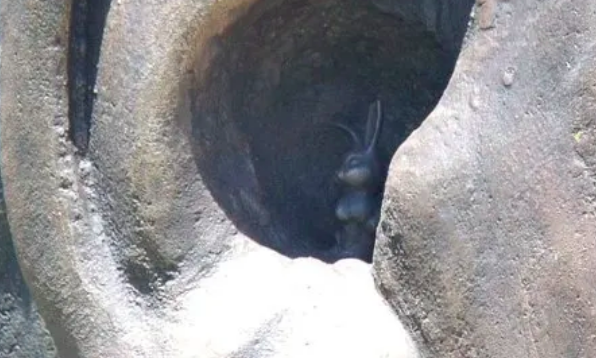Too Much Hare in Your Ear

When Nelson Mandela died on December 5, 2013, the world mourned. Mandela, the activist who not only ushered in an end to apartheid in South Africa but also became the nation’s first black head of state, was, figuratively speaking, a giant among men. Which is why it’s only appropriate that shortly after his death, his memory was honored with the unveiling of a giant statue of him. Located in Pretoria, the nation’s administrative capital, the statue is nine meters (29.5 feet) tall with an enormous wingspan, as seen below.

It’s a majestic homage to a man who truly defined the nation, setting it on a path of equality and equanimity. It captures his joy and openness as he embraces his home nation; it’s a welcoming sight for those who visit.
And originally, it had a little rabbit hidden in its right ear.

Can’t see it? Let’s zoom in a bit.

What the hare is going on in there?
The rabbit has nothing to do with Mandela or his legacy; rather, it was meaningful to Andre Prinsloo and Ruhan Janse van Vuuren. Those are the two men who were commissioned to create the statue, and while getting to do so was an honor (and besides, they were paid fairly for the project), they also wanted public credit for their work. Specifically, they wanted to sign it — hardly a ridiculous request for an artist. But the government declined that request, despite the fact that the statue’s fabrication was rush job. Mandela’s death was just 11 days before South Africa’s Day of Reconciliation, a holiday marking the end of apartheid. And the nation’s leaders wanted the statue ready to go for that day — and without the artists’ signature.
Enter the hare. The artists, per the Atlantic, “surreptitiously inserted the rabbit because the government had denied their request to engrave their signatures onto the sculpture’s trouser;” the bunny was their alternative way to sign their work. As reported by the BBC, it was “a way of saying how fast they had worked to get the statue made in time – the Afrikaans word for rabbit is haas, and that also means haste.” And perhaps most importantly, they figured, no one would really object because no one is going to notice the addition anyway. After all, who is going to have eyesight keen enough to spy a tiny rabbit more than 25-feet above the ground, hiding in the statue’s ear canal?
Unfortunately for Prinsloo and van Vuuren, they were wrong on that last point. Somehow, within a month, news of the rabbit spread throughout the country — and people weren’t happy. Dali Tambo, the son of an anti-apartheid leader and the CEO of the company tapped to oversee the statue project, was particularly incensed; he told the Guardian that the “statue isn’t just a statue of a man, it’s the statue of a struggle, and one of the most noble in human history,” calling the rabbit “belittling,” “like depicting Barack Obama with a mouse in his nose.” He joined many who called for the removal of the rabbit.
And ultimately, the bunny went away. The sculptors apologized for their bad judgment and, upon orders of the government, removed the hare from Mandela’s ear. According to South African publication You, the whereabouts of the rascally rabbit are unknown.
Bonus fact: In July 1998, Nelson Mandela married Graça Machel; as Mandela was President of South Africa at the time, Machel became the nation’s First Lady. For Machel, that was a somewhat familiar role. More than two decades prior, she was married to Samora Machel, the President of neighboring Mozambique. (Samora Machel died in office in 1986, leaving Graça as his widow.) Graça Machel is the first (and, to date, the only) woman to serve as First Lady of two different countries.
From the Archives: The Statue in Glasgow with a Traffic Cone on Its Head — Sometimes. No rabbits, though.
